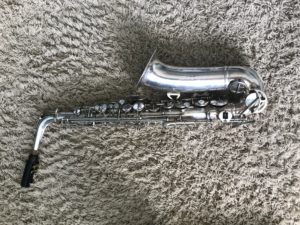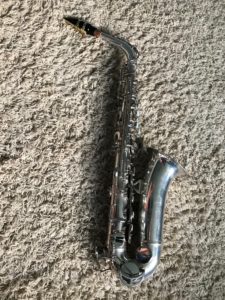King Cleveland 613 Silver Alto Saxophone


Introduction: This instrument was my first ever saxophone purchase back in 2019, which I bought from a little music store called Lundsford’s Musical Instruments in Knoxville, TN which is sadly now out of business. I payed $850 for it which admittedly was more than it was worth even with its brand new pads and replaced case, but I didn’t really know as much about buying instruments back then as I do now. I was an excited young high school graduate full of my own ideas who cared more about the aesthetic appearance and uniqueness of the instrument rather than the playability, and this instrument was quite an eye catching horn to say the least. It served me through my first three or so years of my undergraduate college degree, appearing in jazz band, classical and jazz lessons, and saxophone ensemble before I purchased a Yamaha alto saxophone later.
General Information: The King Cleveland 613 is a student model alto saxophone built in the 1960s-1970s by King H. N. White of Cleveland, Ohio. They were comparable to Selmer Bundy and Conn “Shooting Stars” student alto saxophones of the same era. The King brand is now owned by Conn-Selmer and is mostly used on brass instruments, and as far as I know the King brand is no longer used on woodwind instruments.
Playability and Tuning: First impressions on this alto are pretty good, with the instrument having a big full tone. The sound is a little bright and all registers are responsive. The higher register and palm keys really sing out nicely and have plenty of depth, not getting thin like some other horns I have played. The low notes have quite a punch, and I find these left hand bell key altos in general to have much better sounding low notes than their more modern right hand counterparts. Intonation is where things get a little rough with this horn. Alto saxophones in general seem to have more intonation tendencies than the tenor and baritone saxes in my limited experience, and this saxophone seems to really exaggerate those tendencies. Middle D is often sharp on most altos assuming the F# in both octaves is in tune, and on this horn the middle D is well over 25 cents sharp, and the Eb and E above that is about the same. The F natural continues this 20+ cents sharp trend before arriving at a mostly in tune F# with octave key. The problems continue in the low register, with low Eb and low D being the worst at about 15-20 cents flat. Again, much more variation then I have found on other altos and it requires a whole lot more than a causal lip up or lip down to correct on the fly. I have tried lots of alternate fingerings and adjustments with different mouthpieces and nothing really makes a significant difference. The palm keys also seem to be quite sharp compared to the rest of the registers of the horn. The altissimo is quite a challenge to get out of this saxophone in the first place, and you can forget being in tune when it does finally speak. In fairness though, I am not the greatest at saxophone altissimo as saxophone is more of a secondary instrument for me, so a primary saxophone player with more practice in the altissimo might have better luck. Overall, the horn produces a nice tone but the intonation problems can make playing it more of a pain than a pleasure as the sharpness of that middle register sticks out like a sore thumb, even when you play on your own.
Construction and Build Quality: As you can see in the pictures, the body of the instrument actually appears to be silver plated rather than the typical lacquer that appears on most student models and on pretty much every other King 613 I have seen. Though I know that I will be told that this is nickel plated, I do believe that this is truly silver plated because I have left this out on a stand on multiple occasions and the body tarnishes to a grayish black color like you would expect silver too. That being said I have no idea why this was done to this horn, or if it was done at the factory or not. The plating looks like it was applied well and is in good shape, and I would guess that this was done to the instrument after the initial manufacture as I have never seen another silver plated King 613 student alto. The silver plate certainly catches your eye, and makes for a beautiful looking saxophone when cleaned and taken care of, and on that note I should add that it requires regular cleaning in order to keep it looking like this. Oddly enough though, the keywork appears to be nickel plated as it would appear from the factory.
The keywork follows the layout of the typical left hand bell key alto sax, and truly I like the layout and feel of this older keywork style more than the modern layout. It is solidly constructed and has good action, and the keys are about impossible to bend without exerting some significant force which is a good trait for any instrument, especially a student model where durability is a priority. That being said though, this instrument has to have the noisiest keywork I have ever experienced in my life, and that is saying something given some of the poorly maintained saxophones I played in high school. Just about every key clicks or knocks, and it sounds like it is just metal on metal everywhere. It was so bad that it became a running joke between me and the second alto player in jazz band and my saxophone professor as well. Now I know you all are saying “Obviously it is missing key corks” but the fact is that it isn’t. I have went through this horn multiple times while owning it, making sure that every key has the appropriate corks installed, and still somehow this thing sounds like a percussion instrument. The side Bb and C keys along with the the right hand stack are the worst offenders, and I could not imagine having to trill with those side keys. You would hear more of the keywork slamming around than the actual trill. After inspecting it more closely, I attributed a lot of this clacking to loose key mechanisms that didn’t fit snugly on the rods, which cased them to rattle around when keys were actuated. I cannot tell if this is bad design or if it needs some kind of adjustment that I don’t know about. A shop might be able to fix some of this, but I don’t know if it is worth the money given to the tuning issues.
Case: I didn’t receive the factory King case with this horn, so there is no point in reviewing that. However, it did come with this Guardian branded case so I will give you my thoughts on it. The case one of those travel cases and it only has room for the instrument body itself inside. Any accessories must either be stored in a separate place, or in the case of the neck down the bell of the saxophone which I really don’t like. This sounds like instrument damage waiting to happen, and there is no way to put anything else in the case without sticking it down the bell or heaven forbid laying it on the saxophone itself in the case. I mean, I guess the case would work fine for someone who carried their reeds and mouthpieces (and maybe their neck?) in a separate bag or something, but as someone who likes to keep their mouthpieces and other accessories with their associated instruments, this case is impractical for my needs and taste. Not to mention, I had continuous issues with the zippers popping off of the case which made it hard to open without them. Needless to say, the Guardian case was not impressive to me and I would not recommend it.
Conclusion: The King Cleveland 613 alto sax is a well built classic student horn that would be fine for a beginner or casual player, and this particular example certainly stands out with its unique silver plating and its left hand bell key configuration. That being said, I think a even a serious high school player would quickly notice the severe tuning issues and the comically loud keywork and would find it quite annoying to play. You all know I am fond of old student instruments and try to give them the benefit of the doubt, but truly even I was found looking for something better after spending a couple of years with this alto which is something that rarely happens with me and student instruments. In fairness, this is the only King 613 alto I have ever played and like I said before I do believe there was some custom work done to this horn with its silver plating and all, so it is hard to say what else might have been done to it which might have landed it in this condition. I also found some interesting craftsmanship regarding the so called “overhaul” it had received when I bought it such as stripped rod heads, missing washers on keyguard screws, and places where key cork should have been installed but was not among other things which I had to correct myself, so it is possible that this horn is just set up poorly and another shop could eliminate some of those issues. And who knows, it could have been a manufacturing defect or bad design in the first place that led to these issues. It is really hard to say in all honesty given that I do not know the history of the instrument.
So what can we learn from this? First off, be sure to thoroughly play an instrument whether modern or vintage before buying it and check it several times against a tuner in all ranges and compare that to other instruments if possible. Just because one note is in tune doesn’t mean the rest of it will tune well. Secondly, know the tendencies of the instrument you are looking at and be sure to check those trouble spots. I didn’t really know the alto sax all that well at that time, and had no idea to even check for a sharp middle D. Third, if you don’t know the tendencies, bring someone with you who knows the instrument in question well to give input and advice on the horns you are trying. And lastly, playability is always more important than the looks of an instrument, so if you encounter a beautiful instrument whether new or old, be sure that it plays as good as it looks.
